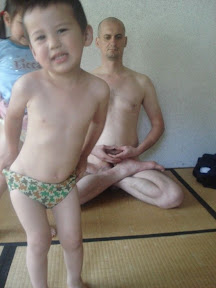Adult practice: Part 39
|
 | One year ago I started to discuss the question of how to cross the legs during zazen. Until now, I have only given my answer to the first of my questions: Are we supposed to really have the tips of the toes in line with the outer edge of the thighs? My answer is: Yes, the toes should be in line with the outer edge of the thighs, as can be seen on the illsutrations by Sawaki Roshi and Uchiyama Roshi on the left and right. Thus your two knees and the base of the spine should form an equilateral triangle. To achieve that, in other words, you have to try to get your heels as close to the trunk as possible. Ideally, the heels should be touching your trunk. If they do, your toes will naturally be in line with the outer edge of the thighs and your knees and spine form an equilateral triangle. This is not easy for everyone, but at least that should be the posture we are aiming at. In September of 2007 we had a look at some stretching exercise that help to become more flexible. |
 |
Surprisingly, most other instructions in zazen tend to put not much importance on this, if not to say they completely ignore this point. Most of the pictures, drawings or even buddha statues show people in zazen with their feet only half way up their thighs, on top of their knees or in other awkward positions. If we spend lots of hours in the sitting posture and are aware of the fact that the mind can not be seperated from the physical posture, shouldn't we pay more attention to the exact way we sit? Below are two pictures my wife took of me aiming at the correct way to cross the legs.


At some point in the future, I would like to discuss the role of the cushion and its height for crossing the legs in the most stable way.
No-one's posture is perfect, and if you look at the picture above on the right, you might see that my head and shoulders are turned the left, and that the tip of my nose isn't exaclty above the spot where my thumbs touch. As a matter of fact, I was surrended by my playing kids at the time.
Check out the left one at 4:15, when he shows the "exact position". And the one in the center at 6:10, when he finally gets around to demonstrating the "way how to create a clear awareness". Somehow I can't help the feeling that they are both the same guy as the one in the video on the right, on the left disguised with glasses and artificial eye brows, in the center with the glasses but without the hair. Am I wrong? Check for yourself.
Lets get to the second question concerning the crossing of the legs: Is it necessary to always lift the left (and not the right) foot only when sitting in half lotus, and is it necessary to lift the right foot first and then the left foot when sitting in full lotus? Dogen Zenji mentions only one way, do we have to follow him here or is it OK to cross the left and right foot the other way around?
In the case of the first question, I said that we should follow Dogen Zenji literally. In the case of the order of the left and right foot though, not only do I think that we don't have to follow Dogen so striclty, I actually think it is better to switch legs from time to time even if the way Dogen recommends us to sit is more comfortable than the other way around. This is the case with my legs: In the beginning, I could not sit with my right foot on top of my left thigh at all, while sitting in half lotus with the left foot on top of right thigh was possible for 15 minutes or so. I gradually improved, and eventually I became able to sit a whole day of sesshin in half lotus. But even then I would sit for ten or more periods with the left foot raised on the right foot and only one or maybe two periods with the right foot on top of the left thigh. Not because Dogen recommends so, but simply because sitting with the left foot up for the tenth time caused less pain than raising the right foot only once. And even when I was able to sit in full lotus the way Dogen describes it, it still wasn't possible for me to sit with the left foot raised first and the right foot placed on top of the left leg after that for a long time. Even now it is much easier for me to lift the left foot first and then place the right foot on top of the left thigh, than the other way around. It seems as if there is some kind of asymmetry, somehow the flesh and bones fit the one way better than the other. Still, I am making a point of switching each period. First sitting one period with the left foot up, then sitting the next period with the right foot up.
The next question then is: Why does Dogen make a distinction between left and right in the first place? Why doesn't he just say: "Lift either one foot to sit in half lotus, and lift both feet on top of the opposite thigh to sit in full lotus"? Is there a meaning in the distinction, and if there is, it is important? We will come back to these questions next time.
| <<< Previous chapter | Contents | Next chapter >>> |


